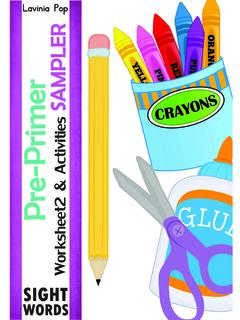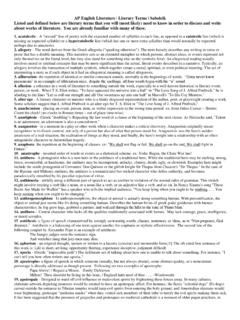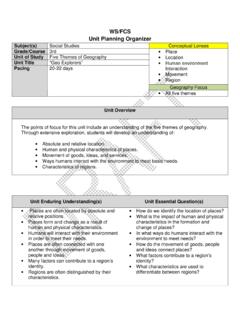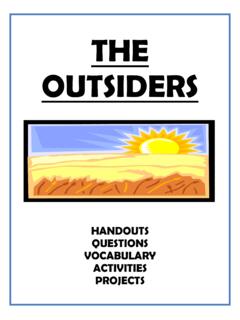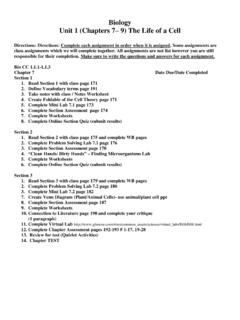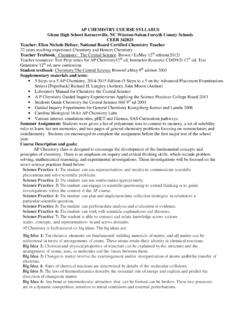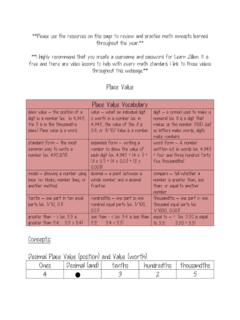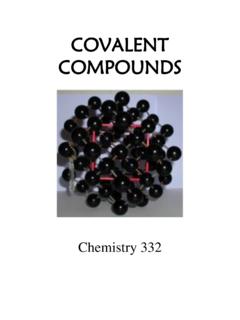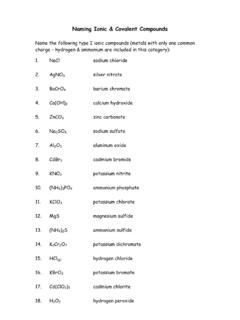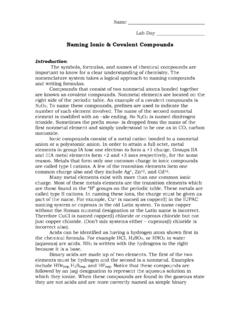Transcription of Covalent Compounds Worksheet - Winston-Salem/Forsyth ...
1 Ionic and Covalent Bonds Physical Science Name: _____ Period: _____ Date: _____ Essential Question: How is ionic bonding different from Covalent bonding? Comparison of Properties of Ionic and Covalent Compounds Because of the nature of ionic and Covalent bonds, the materials produced by those bonds tend to have quite different macroscopic properties. The atoms of Covalent materials are bound tightly to each other in stable molecules, but those molecules are generally not very strongly attracted to other molecules in the material. The atoms (ions) in ionic materials show strong attractions to other ions in their vicinity.
2 This generally leads to low melting points for Covalent solids, and high melting points for ionic solids. For example, the molecule carbon tetrachloride is a non-polar Covalent molecule, CCl4. It's melting point is -23 C. By contrast, the ionic solid NaCl has a melting point of 800 C. Properties of Covalent Compounds Gases, liquids, or solids (made of molecules) Atoms share electrons to become stable. Usually occurs between non-metals. Hydrogen and another non-metal chemically combines through Covalent bonding. Low melting and boiling points Poor electrical conductors in all phases Many soluble in non-polar liquids but not in water Properties of Ionic Compounds Crystalline solids (made of ions) Metal atoms give electrons while non metal atoms get electrons to become stable.
3 Usually occurs between metals and non-metals. High melting and boiling points Conduct electricity when melted Many soluble in water but not in non-polar liquid Clarifying Questions: 1. Why do solid Covalent Compounds ( molecules) have low melting points? _____ 2. Why do solid ionic Compounds ( ions) have high melting points? _____ 3. How are carbon tetrachloride and sodium chloride different from each other? _____ Instructions: Classify the following properties as either Ionic or Covalent Compounds . Write ionic or Covalent on the space before each property. _____ 4. Atoms share electrons to become stable.
4 _____ 5. High melting and boiling points _____ 6. Conduct electricity when melted _____ 7. Usually occurs between non-metals. _____ 8. Poor electrical conductors in all phases _____ 9. Many soluble in non-polar liquids but not in water _____ 10. Crystalline solids (made of ions) _____ 11. Metal atoms give electrons while non metal atoms get electrons to become stabl _____ 12. Usually occurs between metals and non-metals. _____ 13. Hydrogen and another non-metal chemically combines through Covalent bonding. _____ 14. Low melting and boiling points _____ 15. Many soluble in water but not in non-polar liquid Classify the following as metal or non-metal and ionic or Covalent Compounds .
5 Compound First element/atom (metal or non metal ) Second element/atom (metal or non metal ) Ionic or Covalent CH4 Carbon or C is a non metal Hydrogen or H in this case is exhibiting non-metallic properties. Covalent MgCl2 H2O CCl4 HF Hydrogen or H is this case is exhibiting metallic properties. HCl NaCl Mg3P Covalent Compounds Worksheet 1) Based on the properties of the following materials, determine whether they are made of primarily ionic Compounds or Covalent Compounds : a) telephone receiver: _____ b) concrete: _____ c) gasoline: _____ d) candy corn: _____ 2) Name the following Covalent Compounds : a) SiF4 _____ b) N2S3 _____ c) HBr _____ d) Br2 _____ 3) Write the formulas for the following Covalent Compounds .
6 A) diboron hexahydride _____ b) nitrogen tribromide _____ c) sulfur hexachloride _____ d) diphosphorus pentoxide _____ 4) Write the empirical formulas for the following Compounds : a) C2H4O2 _____ b) boron trichloride _____ c) methane _____ d) C6H12O6 _____ 5) List three differences between ionic and Covalent Compounds : 6) Explain why ionic Compounds are formed when a metal bonds with a nonmetal but Covalent Compounds are formed when two nonmetals bond. 7) What are the shapes of the following molecules? a) carbon disulfide _____ b) boron trifluoride _____ c) carbon tetrafluoride _____ 8) What does electronegativity have to do with bond polarity?
7 9) Explain how hydrogen bonding takes place. 10) Why is the bond length of nitrogen much shorter than the bond length of chlorine? 11) What is an organic compound?
